Skim Boards Market Insights and Buying Guide
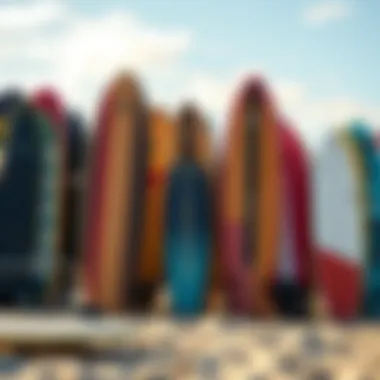
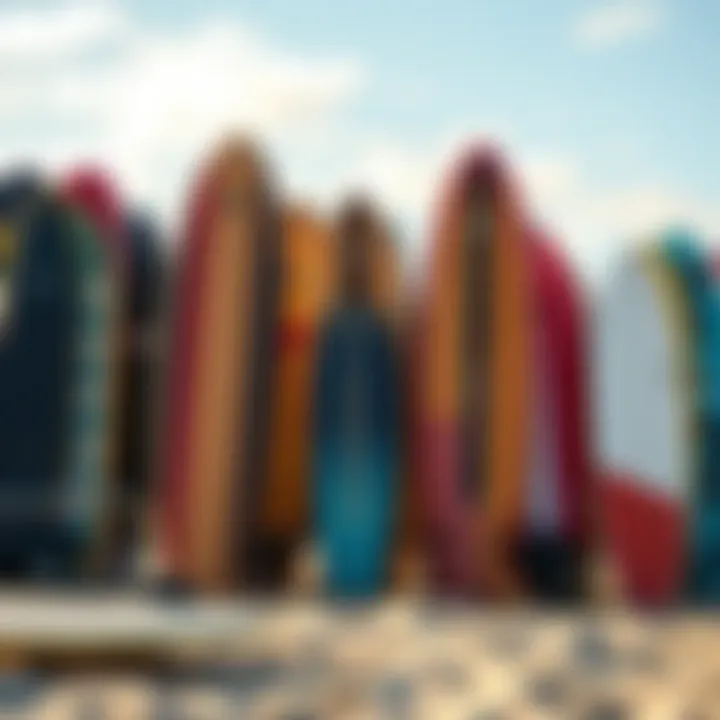
Intro
Skim boarding offers an exhilarating way to connect with the ocean while enjoying the thrill of gliding across its surface. It's a sport that, although closely related to surfing, carves its own niche — often played along the shore as waves crash and recede. For newcomers and seasoned skim boarders alike, the market for skim boards is ever-evolving, presenting a diverse array of options and information. The choices become a bit overwhelming when considering what best suits personal preferences and riding styles.
This guide dives into the multifaceted world of skim boards, encompassing the various types available, the materials that shape their performance, and the key factors to keep in mind while choosing the right board. From understanding the nuances in design and construction to recognizing the major brands that dominate the scene, this guide is tailored for anyone looking to make educated decisions in their skim boarding adventures.
Additionally, we’ll explore the environmental implications tied to the sport and how enthusiasts can minimize their impact. Whether you’re just starting out or looking to elevate your skills, the following sections aim to empower your skim boarding journey with essential techniques and tips, ensuring that you’re well-equipped, informed, and ready to tackle the sandy shores.
Techniques and Tips
Skim boarding is more than just a sport; it's about embracing the rhythm of the ocean and mastering the art of balance. While it may seem simple at a glance, there are specific techniques that can greatly enhance your performance on the board. Let's unpack some essential techniques suited for both novices and experienced skim boarders.
Essential Surfing Techniques for Beginners
- Finding the Right Spot: Look for areas where the water is shallow and the waves break gently. This allows for a smoother start and less risk of injury.
- Foot Placement: Position your feet shoulder-width apart, with your back foot over the tail of the board for better control.
- The Launch: Start by running towards the water, and as you reach the edge of the waves, place the skim board down and hop on quickly. This smooth transition is crucial to maintain speed and stability.
- Balancing and Steering: Lean into your turns slightly, using your hips to guide the board. Practice shifting your weight to enhance maneuverability and speed.
- Practice Stops: Learning to stop safely is just as important as getting started. Shift your weight back as your board slows down, and step off into the water.
Advanced Maneuvers for Experienced Surfers
For seasoned riders, pushing the limits through advanced techniques can lead to significant improvement and more exciting experiences. Here are some maneuvers to consider:
- 360 Spin: To achieve this, maintain your speed as you approach a wave and pivot your body to spin the board beneath you.
- Shuvit: A tricky one, the shuvit involves popping the board while it spins beneath you. It combines balance, timing, and a bit of courage.
- Carving Turns: This technique requires precision, allowing for sharp cuts on the water's surface, enhancing speed and control.
- Jumping: Practicing jumps off small waves can advance skills and boost confidence, but be mindful of landing on the board smoothly to avoid wipeouts.
As you practice these techniques, always keep in mind the importance of safety and maintaining respect for the ocean. It’s advisable to wear protective gear and be aware of the currents and tides before diving into the sport.
"Mastering the basics is key before moving on to the more complex maneuvers; even the pros have their foundations well set."
Gear and Equipment
Given the integral role gear plays in the skim boarding experience, it's essential to familiarize yourself with the types of boards available, as well as any must-have accessories. The right equipment not only enhances performance but also increases enjoyment.
Types of Skim Boards
- Wooden Skim Boards: Great for beginners, wooden boards provide stability and are typically heavier, making them easier to control on flat surfaces.
- Foam Boards: Lightweight and buoyant, foam boards help with balance and are excellent for tricks and maneuvers.
- Fiberglass Boards: For experienced skim boarders, fiberglass boards may enhance speed and performance, ideal for catching bigger waves.
Must-Have Accessories for Every Surfer
- Wetsuit: Depending on the water temperature, a wetsuit can provide comfort and warmth during your skim boarding adventures.
- Skim Board Bag: To protect your board from scratches and dings, a quality bag is a wise investment — particularly when traveling.
- Earplugs: Protecting your ears from water can help prevent discomfort, particularly for those who skim board frequently.
In the end, each of these factors plays a pivotal role in shaping your dockside experience and performance on the water. Having the right gear and mastering techniques will pave the way for countless thrilling adventures in the swell.
Understanding Skim Boards
In the realm of water sports, skim boarding often finds itself in the shadows of more popular activities like surfing. However, understanding skim boards is crucial for those looking to fully embrace this exhilarating sport. Whether you're a newcomer or a seasoned rider, grasping the nuances of skim boarding sets the stage for enhanced enjoyment and performance.
Definition of Skim Boarding
Skim boarding is a water sport that involves riding a small board on the shoreline, typically in the shallow waters where waves break. The rider throws down the board onto the wet sand, runs and hops on it as it glides over the water's surface. Unlike surfing, where the focus is on catching waves, skim boarding allows for a different kind of thrill, blending agility and balance as riders perform tricks and maneuvers.
This sport is not merely an offshoot of surfing; it has its own identity and appeal. Riders can look forward to the rush of the ocean breeze and the splashes of water that come with riding the skim board, as well as the sense of freedom it offers when skimming along the beach.
History and Evolution
Skim boarding's story stretches back to the 1920s in California, where it emerged as a means for surfers to get back to shore easily from the waves. Armed with nothing more than wood and a bit of ingenuity, early boards were crafted from solid planks, making them quite different from today’s diverse materials and designs.
As the decades rolled on, innovations began to shape how the sport is perceived. The 1970s marked a significant turning point as enthusiasts developed lighter and more durable boards using new materials like fiberglass and foam. This evolution has led to the modern skim boards we see today, which cater to both beginner and expert riders. The sport's reach has since grown worldwide, with competitions sprouting up and communities forming, driven by the shared love for skim boarding.
Differences Between Skim Boarding and Surfing
At first glance, skim boarding may seem like a mere footnote in the larger surfing saga. However, it possesses distinct characteristics that set it apart. Here are a few key differences:
- Location and Setting: Skim boarding is primarily performed on the shore, using broken waves and shallow water, unlike surfing which requires deeper waters.
- Board Design: Skim boards are typically shorter and flatter than surfboards, allowing for quick take-offs and easier tricks.
- Technique and Skills: Riding a skim board depends a lot on foot speed and balance. While surfing demands wave riding skills, skim boarding thrives on running and agility.
- Tricks and Styles: The types of tricks vary; skim boarders often focus on flips, spins, and sliding across water. Surfing, by contrast, is about carving waves.
Understanding these distinctions can help you choose the right board and approach based on your personal interests and skill set. When you comprehend the core features of each activity, whether you're riding the waves or playing on the shore, it enhances your experience remarkably.
As we delve deeper into this guide, you'll explore variations in board types and other essentials. With an informed basis on what skim boarding really entails, you can now embark on your adventure into the fascinating world of skim boards.
Types of Skim Boards
When it comes to selecting a skim board, understanding the Types of Skim Boards available can greatly influence your riding experience. Each type comes with its own materials, design elements, and performance characteristics. The choice you make can affect your ability to perform tricks, ride in different water conditions, and even your overall enjoyment of the sport.
Wooden Skim Boards
Wooden skim boards have been the go-to choice for many beginner and intermediate riders. Made primarily from plywood or solid wood, these boards offer a good balance of sturdiness and weight. They tend to float well and are generally easy to maneuver, making them suitable for those learning the ropes of skim boarding.
However, wooden skim boards can be prone to water damage if not properly cared for. It's crucial to keep them dry after use and store them away from damp conditions. Plywood boards are less expensive than other types, so they make an excellent choice for those who are just dipping their toes into the sport without wanting to break the bank.
"Wooden skim boards can be an excellent starting point for newcomers, merging affordability with reliability."
Epoxy Skim Boards
If you’re looking for performance and durability, epoxy skim boards are worth considering. These boards are often made with a composite of lightweight materials that provide better buoyancy and quicker responses on the water. The construction allows for a thinner profile without sacrificing strength, leading to enhanced performance when executing tricks or at higher speeds.
Riders who are more advanced typically favor epoxy boards due to their lightweight nature, which can translate into improved agility and ease of control. However, they come with a heftier price tag, appealing to those serious about elevating their skim boarding skills.
Plastic Skim Boards
Plastic skim boards are commonly found in many beach shops, often marketed towards younger riders or beginners. These boards are affordable, durable, and forgiving, making them an accessible choice. Their construction allows for basic tricks and fun in various water conditions, although they may not perform as well in rough waves compared to more specialized boards.
A notable downside is that plastic boards may not provide the same level of speed or responsiveness as wooden or epoxy boards, limiting their utility for serious skim boarders. Still, they are an excellent option for casual use, allowing fun times at the beach without significant financial commitment.
Foam Skim Boards
Foam skim boards present another viable option, particularly for beginners or those interested in a safer and more forgiving ride. The soft foam provides extra cushioning, reducing the impact from falls, which is appealing for inexperienced users. Moreover, these boards are extremely buoyant, making them a great choice for shallow waters or lower wave conditions.
However, foam boards are generally less durable compared to wooden or epoxy varieties. They can wear down easily, especially if used on rough surfaces, but for casual skim boarding, they’re a solid pick. Their lightweight nature makes them easy to carry and great for family outings by the shore.


Ending
Understanding the different types of skim boards on the market is essential for anyone interested in the sport. Each type has specific benefits and considerations, shaping riders' performance in various water conditions. Making an informed choice not only enhances the overall skim boarding experience but also aligns the board with specific skill levels and riding styles.
Essential Features to Consider
When it comes to skim boarding, understanding the essential features of a skim board can make the difference between a mediocre day at the beach and an exhilarating experience. Selecting the right board requires careful thought to ensure performance, comfort, and safety on the water. This section highlights critical elements to examine when choosing a skim board.
Board Length and Width
The dimensions of a skim board play a pivotal role in its performance. Generally,
- A longer board offers better stability and glides smoothly over water, making it suitable for beginners or those cruising along the shore.
- Conversely, shorter boards enhance maneuverability and are favored by advanced users for tricks and jumps.
Width also factors into the equation. Wider boards provide more surface area, which is beneficial for balancing, while narrower boards allow for sharper turns and faster rides. Ultimately, it’s crucial to select a board that aligns with one’s skill level and preferred riding style. Aiming for a happy medium often works wonders for those looking to improve.
Thickness and Weight
Next, the thickness and weight of a skim board might seem trivial, but they heavily influence usability. Thicker boards typically are more buoyant, which helps to maintain speed in the water, especially when waves are present. For instance, a thicker board can easily skim above the surface rather than dragging through, allowing for an uninterrupted ride.
On the weight front, a lighter board can enhance agility. This factor is particularly significant when attempting tricks, as it allows for quicker rotations and flips. However, too much lightness may compromise durability. Striking the right balance here is vital for both safety and performance.
Tail Shape and Rail Design
The tail shape is another factor that can’t be ignored. Different tail designs cater to varying riding styles:
- A square tail offers excellent stability and support, ideal for beginners.
- A round tail allows for smoother turns and transitions, beneficial for more experienced riders looking to carve through waves.
Similarly, the rail design impacts how the board interacts with the water. Sharp edges facilitate a faster and more aggressive ride, while rounded edges provide a softer touch and smoother ride, which might be preferred by those who are less adventurous.
"In skim boarding, the nuances of design elements can influence both performance and the rider's enjoyment. Consider these features your toolkit for adventure."
At the end of the day, being aware of these essential features not only helps in choosing the right skim board but dramatically enhances the overall skim boarding experience. Like they say in many communities, a skilled rider knows their board inside and out.
Popular Brands of Skim Boards
The realm of skim boarding is vibrant, filled with brands that not only offer quality but also set trends on the sandy shores. Understanding the essence of popular brands is paramount, especially for both novices and seasoned boarders. These companies often represent a treasury of experience, innovation, and community connection that add distinct value to the skimboarding experience.
When choosing a skim board, one must consider several elements from durability to design. Established brands tend to use high-quality materials, which compromise on neither performance nor safety. Moreover, these companies frequently have a loyal customer base, offering a plethora of reviews and feedback, helping buyers make informed decisions. A well-known brand also often means better warranty and support, providing peace of mind.
In essence, aligning with popular brands provides more than just a board; it enhances the overall journey into skimboarding. Let's delve into three prominent players in this field.
Company A Overview
Company A has made quite the splash over the years in the skimboarding market. Known for its cutting-edge designs and strong community presence, this brand continually evolves to meet the needs of its customers. They offer a variety of boards suited for different skill levels, from beginners just trying to stay upright to advanced riders who seek out tricks and speed.
Their boards are generally made from high-quality materials, providing a perfect balance of flexibility and strength. Many users rave about their lightweight models, which are specifically crafted for ease of maneuverability in waves. Besides functional benefits, Company A engages actively with its user base, facilitating workshops and competitions that not only showcase talent but also promote the sport as a whole. This level of community involvement with enthusiasts is what sets them apart.
Company B Overview
If there's one name that consistently rises to the top when talking about durability, it's Company B. With a focus on crafting boards that withstand the test of time, they appeal to seasoned skimboarders and those who may prioritize longevity over trend. Their boards often feature unique designs that prioritize stability, making them popular among riders in varying water conditions.
Company B also offers customized boards, allowing enthusiasts to infuse personal flair into their gear while ensuring functionality tailored to their skill set. Moreover, they provide detailed guides on their website for care and maintenance, which reflects their dedication to customer education. This commitment to quality is why skimmers often trust and seek out Company B when in the market for their next board.
Company Overview
Rounding out the trio, Company C has carved a niche with its bottom-line sharp pricing without sacrificing quality. Their boards are particularly favored by those just stepping into the world of skimboarding. They might not have the extensive roster of elite athletes endorsing them, but their focus on accessibility makes them a hitting choice for budget-conscious buyers.
Parents often gravitate towards Company C for their children's first skim board, due to straightforward designs that are both easy to use and safe. Also, by offering various colors and styles, they appeal to younger audiences looking to express themselves on the beach. Company C serves as a stepping stone to a sporting lifestyle for many new enthusiasts, ensuring an entry point that doesn’t feel intimidating.
In summary, the brands discussed not only foster personal growth but also cultivate a milieu for skimboarding as a community-driven sport. Investing in a recognized name often translates into a more supportive and rewarding experience on the waves.
Where to Buy Skim Boards
Finding where to purchase skim boards is more than just about pointing to a shop and grabbing one off the shelf. It’s about understanding different venues that cater to the unique needs of skim boarders. Each option comes with its distinct advantages, considerations, and flavors of experience. Whether you’re a newcomer to the sport or a seasoned rider looking for that perfect glide, knowing the best places to shop makes a world of difference.
Local Surf Shops
Local surf shops often serve as the heartbeat of surf culture in their communities. These places aren't just retail outlets; they’re gathering spots for like-minded individuals who share a passion for riding waves.
When considering purchasing a skim board at a local surf shop, you have several key benefits:
- Personalized Advice: The staff, typically experienced surfers themselves, can provide invaluable insights tailored to your skill level. They'll help you pick a board that resonates with your technique and style.
- Hands-On Experience: You can inspect the boards up close. Feeling the weight and texture in person helps decide if it’s the right fit for you.
- Community Vibes: Local shops often host events, lessons, or community meets. This can be a great way to integrate into the local skim boarding or surfing community, and you may find new friends eager to share tips.
However, the variety may not be as broad as what you could find elsewhere, and prices can sometimes be higher due to the overhead of running a brick-and-mortar establishment.
Online Retailers
As anyone who has braved an internet shopping spree knows, online retailers open up a vast marketplace. Purchasing skim boards online offers numerous perks:
- Wide Range of Choices: You can explore countless brands and board types all from the comfort of your couch.
- Customer Reviews: Take advantage of user feedback. Reading about other riders’ experiences can guide your decision.
- Price Comparisons: Websites allow quick comparison across retailers, ensuring you find the best deal without driving from store to store.
Be wary, though, as this convenience comes with its own set of challenges. Without the opportunity to inspect your board in person, you may inadvertently end up with a model that doesn’t suit you. Delivery times may also vary greatly, and the return process can sometimes be complex if you’re dissatisfied.
Second-Hand Options
Let’s not overlook the second-hand market, which can be a goldmine for budget-conscious skim boarders or those looking for unique finds. There are various platforms and methods to find pre-owned boards:
- Craigslist and Facebook Marketplace: Browse local listings for boards that have found a previous owner.
- Specialized Forums: Niche sites and online communities often have sections dedicated to selling gear. Joining these forums not only allows you to buy but also aids in gaining insight about specific boards that pique your interest.
- Swap Meets and Local Events: Sometimes, clubs and groups hold events where members can exchange or sell their equipment. It’s a chance not just to buy but to network and learn.
While second-hand boards can save you a pretty penny, ensure you check for wear and tear. Look for signs of deep scratches, cracks, or delamination. You must also make sure that it aligns with your skill level and riding style, as using an unsuitable board might hinder your development.
Whether you choose to shop locally, browse online retailers, or dive into the second-hand market, each venue has its pros and cons. Weigh your options carefully to find the skim board that best suits your riding style, experience level, and conditions.
Factors Influencing Skim Board Performance
When it comes to skim boarding, several critical factors come into play that influence how well a board performs in varying conditions. Skim boarding is not just about picking any board and hitting the beach; it’s about understanding how specific elements affect your ride, your enjoyment, and ultimately, your success on the water. Tailoring your skim boarding experience to these factors means paying attention to water conditions, your personal experience level, and the types of waves you’ll be riding.
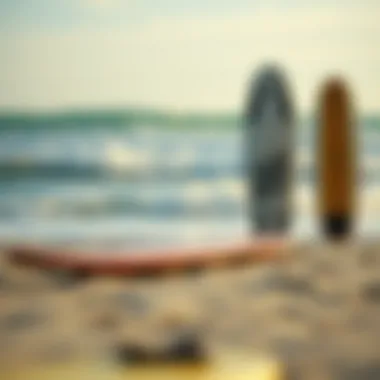
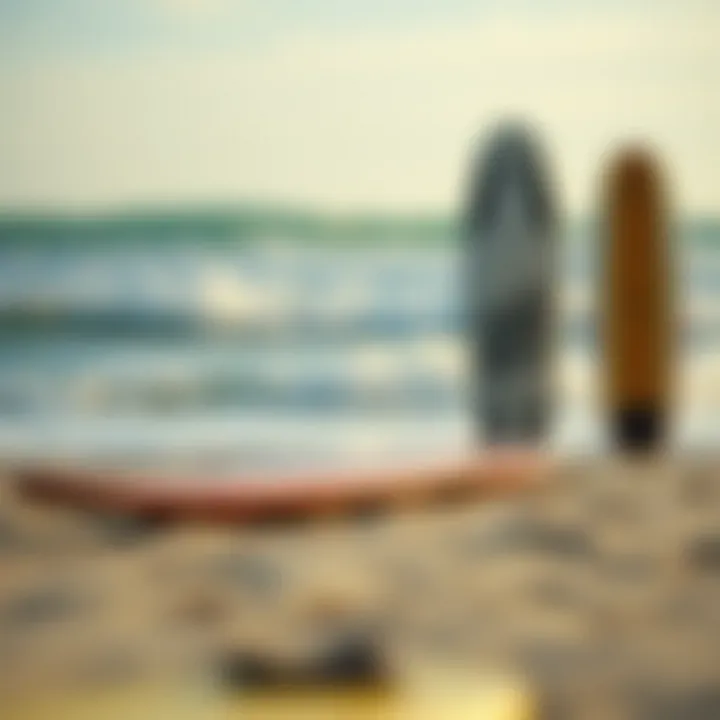
Water Conditions
Understanding water conditions is fundamental to skim board performance. This encompasses the water's temperature, salinity, wave height, and the beach's gradient.
- Shallow vs. Deep Water: In shallow waters, skim boards can glide over the sand, but they may not provide the necessary lift if the water is too shallow. Conversely, deep water can affect speed and control; thus, choosing the right place is essential.
- Temperature: Cold water can affect your board's material, particularly plastic and foam boards, leading to stiffness or brittleness. Warm water allows for better flexibility, enabling the board to perform optimally.
- Current and Tides: Tidal changes can significantly impact water conditions. When tides are low, waves may be smaller, while high tides can create more powerful waves—vital for advanced maneuvers. Being aware of these nuances can enhance your skim boarding experience.
"The ocean is a living, breathing entity; tap into its rhythms to maximize your skim boarding adventures."
Rider Experience
A rider's experience can alter the way a skim board performs. Newbies and seasoned pros will notice vast differences in their rides based solely on their skills and understanding of skim boarding dynamics.
- Skill Level: Novices may struggle with balance and control, leading to poor performance regardless of board quality. As skills improve, techniques like foot placement and weight distribution come into play, allowing for smoother rides and trick execution.
- Endurance and Strength: Riders who are physically fit and possess good stamina will find themselves more adaptable to varying conditions, enhancing their performance. This aligns with how well one can withstand falls and recover from less-than-perfect rides.
- Knowledge of Equipment: Familiarity with the board's features—such as tail shape and material—helps in making split-second decisions when performing tricks or navigating waves.
Wave Types
Not all waves are created equal, and with that comes a need to adapt and change strategy based on the type of waves present. Each wave type offers its own set of challenges and opportunities.
- Choppy Waves: These can be tricky for beginners; they can create unpredictable bumps that affect stability. Adjustments in riding stance and technique may be necessary.
- Glass Waves: Ideal for performance, these smooth waves offer unmatched opportunities for tricks and glides. Riders can capitalize on these conditions for long rides and impressive aerial maneuvers.
- Beach Break vs. Point Break: Beach breaks are ever-changing and may present challenges for beginners. Point breaks typically offer more predictable waves, making them favorable for progression.
Understanding these factors allows riders to enhance their performance effectively. Whether you're hitting the local beach for a quick session or planning a more adventurous skim boarding excursion, these elements will provide insight into selecting the right skim board and technique for your environment.
Maintenance and Care for Skim Boards
Caring for your skim board is crucial to ensure long-lasting performance and enjoyment on the water. A well-maintained board not only enhances your riding experience but also saves you from costly repairs down the line. With the saltwater, sand, and the typical wear-and-tear from tricks, each aspect of maintaining your board becomes essential. Let’s break down the key areas that every skim board enthusiast should focus on: cleaning, storing, and repairing their boards.
Cleaning Techniques
Cleaning your skim board regularly is like giving it a refreshing spa day. After a fun day at the beach, it’s tempting to leave your gear haphazardly in the sand. However, neglecting to clean your board can lead to gradual degradation. Here’s how to keep your board spick and span:
- Rinse with Fresh Water: Immediately after using your board, rinse it with fresh water to remove salt, sand, and other debris. This simple step can prevent corrosion and help maintain the board’s finish.
- Use a Soft Cloth: For stubborn stains or marks, gently scrub the surface with a soft cloth or sponge. Avoid using abrasive materials, as they can scratch or damage the surface.
- Dry Thoroughly: After washing, ensure you dry your board completely. Leaving moisture can lead to mold or weaken the materials over time.
"Regular cleaning not only enhances performance but also prolongs the lifespan of your skim board."
Storage Recommendations
Where you store your skim board can make a world of difference in its longevity. Proper storage prevents warping and damage, especially in fluctuating temperatures. Here are key tips to consider:
- Find a Cool, Dry Place: Keep your board out of direct sunlight to avoid warping and fading of the graphics. A temperature-controlled environment is ideal, particularly if you live in areas with extreme weather conditions.
- Vertical Position is Key: Store your skim board upright or in a vertical position to prevent bending. Many enthusiasts use wall racks designed specifically for boards, which keeps them safe and accessible.
- Avoid Heavy Stacking: If you need to stack boards, place lightweight boards at the top of the pile. Ensure nothing heavy is resting on them, as this can cause dents or bends.
Repairing Damage
No matter how careful you are, accidents happen. Therefore, knowing how to repair your skim board is essential. The key is catching and addressing damage early before it worsens:
- Inspect Regularly: Check your board frequently for cracks, chips, or scratches. Small problems can often be fixed easily if caught in time.
- Use Appropriate Repair Kits: Many brands offer repair kits designed specifically for skim boards. These kits often include adhesive and patches suitable for different materials.
- Follow Instructions Carefully: Each repair kit may require specific steps, especially regarding drying times or the method of application. Make sure to heed the instructions for the best results.
- Consult a Professional: If the damage appears extensive, don't hesitate to seek help from professionals who specialize in surf gear. It might cost a bit, but it can save you a lot in the long run.
Maintaining and caring for your skim board might seem like additional hassle, but it’s worth every effort. A little regular attention goes a long way in enhancing performance and prolonging the life of your equipment. Remember, your board is not just gear; it’s an investment in your adventures on the water.
Environmental Considerations
In a world where environmental awareness is gaining momentum, it's crucial for the skim boarding community to consider the ecological impact of their activities and the products they use. The surf culture has always held a deep connection with nature, but as the sport has evolved, so too have the materials and production methods used in skim boards. This section outlines essential elements like sustainable materials and the rise of eco-friendly brands, showcasing their benefits and implications for the environment.
Sustainable Materials
Choosing skim boards constructed from sustainable materials can significantly reduce the environmental footprint of this thrilling sport. Traditional materials often involve harmful chemicals or resources that do not replenish easily. Instead, many brands are now leaning into materials that promote sustainability. Common examples include:
- Bamboo: This fast-growing grass is not only lightweight and durable but also requires minimal water and no pesticides to thrive.
- Recycled plastics: Utilizing materials destined for landfills, some skim boards are crafted from recycled plastics. This not only helps reduce plastic waste but also conserves energy and resources involved in the production of new materials.
- Natural resins: Unlike petroleum-based resins, sustainable options such as bio-based resins provide a more eco-conscious choice for board production.
By embracing these materials, skim board manufacturers contribute to a reduction in pollution and resource depletion, ensuring that future generations of riders can enjoy pristine coastlines.
Eco-Friendly Brands
As environmental consciousness grows among consumers, several brands have emerged that prioritize eco-friendliness without sacrificing performance. These companies are often at the forefront of innovation, marrying cutting-edge technology with environmentally considerate practices. Some notable eco-friendly brands include:
- Barefoot Skimmers: Known for their dedication to using natural materials and organic finishes, Barefoot offers a range of skim boards specially designed for an eco-conscious clientele.
- Sustainable Surf: A brand committed to restoring the ocean's health, Sustainable Surf creates boards from recycled materials and engages in various environmental initiatives, aiming to make a positive impact on coastal ecosystems.
- Skimboard Co.: This company emphasizes sustainability in its production by sourcing biodegradable materials and implementing sustainable manufacturing processes, promoting a greener future for skim boarding.
"The best way to predict your future is to create it." – Peter Drucker
In this context, the future of skim boarding hinges on embracing eco-friendly practices. Our choices today can pave the way for cleaner beaches and better environmental stewardship, allowing enthusiasts to indulge in their passion responsibly. The collective effort of brands and riders can lead to a healthier planet—one skim at a time.
Skim boarding is not just a sport; it's a lifestyle. Considering environmental impacts when choosing boards helps ensure that this thrilling activity can continue to thrive for years to come. Engaging with sustainable materials and supporting eco-friendly brands reflects a commitment to preserving the very landscapes that make skim boarding possible, reinforcing the symbiotic relationship between riders and nature.
The Skim Boarding Community
The skim boarding community is a vibrant tapestry of individuals with a shared passion for riding the waves and gliding across the shore. This community is not just a grouping of enthusiasts; it’s a network of support, learning, and shared experiences that can greatly enhance anyone's journey into skim boarding. In this article, we examine the elements that create a robust community, including events and competitions that foster camaraderie as well as the online forums where passionate discussions take place.
Events and Competitions
Events and competitions are crucial elements that shape the skim boarding community. They serve several purposes, from promoting the sport to providing a platform for riders to demonstrate their skills.
- Building Skills: Competing in events can push riders to hone their techniques, trying new tricks and strategies. This kind of environment fosters learning and growth.
- Networking: Events are excellent opportunities for making connections, whether it’s with fellow riders, brands, or even instructors looking for talent. Such networking can lead to sponsorship opportunities or friendships that transcend the sport.
- Showcasing Talent: Competitions often allow riders to demonstrate their prowess to a wider audience. This can bring recognition, not just to the winners, but also to the sport itself, helping to attract new riders.
Some noteworthy competitions include the World Skimboarding Championship and various local events that take place during summer months across beaches. These gatherings provide a sense of belonging among participants, as they share laughter, achievements, and sometimes the bittersweet sting of defeat.
"Competitions are not just about winning; they're about bringing the community together, celebrating our love for skim boarding."
— A passionate skim boarder
Forums and Online Groups
In addition to physical events, forums and online groups play a significant role in maintaining the community's pulse. These digital spaces offer valuable resources and support for everyone from beginners to seasoned pros.
- Knowledge Exchange: Online platforms, such as Skimboarders subreddit, allow users to ask questions, share tips, and discuss new techniques. Experienced riders frequently contribute their knowledge, assisting newcomers in honing their skills fast.
- Community Support: The camaraderie found in forums is palpable. Riders celebrate each other’s victories and provide encouragement during setbacks. It cultivates an environment where asking for help is welcomed, not shameful.
- Buying and Selling Gear: Many online groups also focus on buying, selling, and trading gear. This aspect can be particularly helpful for newcomers looking for affordable options or veterans wanting to upgrade their boards.
Joining these groups can be like shaking hands with an extended family. You might begin with a question about gear, but you can quickly find yourself engaged in discussions about the latest tricks or environmentally-conscious materials used in board manufacturing. These connections enrich the skim boarding experience, making it deeper than just a physical activity.
In summary, the skim boarding community is a robust and supportive network that provides vital resources for both new and experienced riders. Whether through the thrill of competitions or the camaraderie found in online forums, this community embraces every individual willing to share the waves.
Safety Tips for Skim Boarding
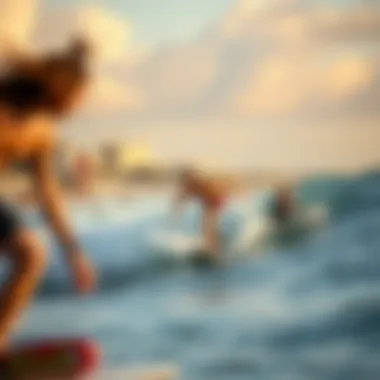
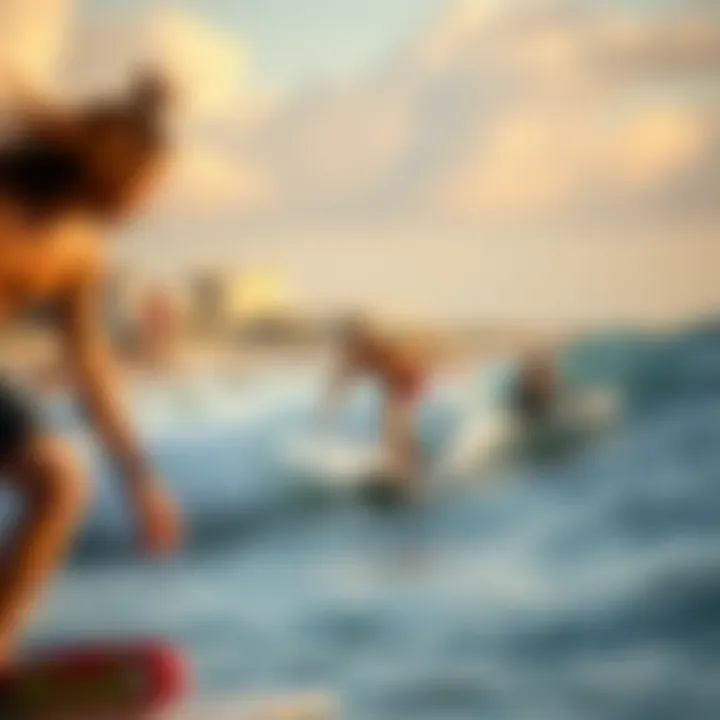
Skim boarding, while thrilling and a means of connecting with nature, does carry its fair share of risks. Practicing safety measures can turn a fun day at the beach into a safe and enjoyable experience. Let’s explore some essential tips that every skimmer should keep in mind to enhance their safety and overall enjoyment, giving more peace of mind when skimming the shore.
Wearing Protective Gear
The primary rule of thumb when engaging in any board sport is to wear protective gear. Safety first should be your motto. While skim boarding may seem like a carefree and laid-back activity, it doesn’t mean one should overlook the importance of safety equipment.
- Helmet: Protects your noggin against any unexpected falls, especially in crowded areas.
- Knee and Elbow Pads: These are crucial for minimizing injuries during wipeouts. Your knees and elbows are the first things that hit the ground when losing balance.
- Proper Footwear: Investing in non-slip water shoes can shield your feet from sharp objects hidden in the sand or rocks that could cause harm.
- Rash Guards or Wet Suits: These not only provide protection from the sun but also minimize the risk of cuts and scrapes while riding the waves.
With all this gear, you may feel a bit like a mummy, but it's better to be safe than sorry. You wouldn’t want a beach day turned into a trip to the emergency room.
Identifying Safe Locations
Choosing the right spot to skim board can make a world of difference in your safety. Not all beaches are created equal when it comes to skim boarding. Certain factors should guide your location choice:
- Water Conditions: Look for areas with moderate waves. Avoid places where the surf is too rough or where strong currents can easily pull you away from the shore.
- Strength of the Wind: A gusty day isn’t the best for skim boarding, as the wind can toss you around, making it easy to lose control. Look for spots shielded from strong winds.
- Foot Traffic: Busy beaches can become a hazard when you’re trying to enjoy a smooth ride. Choose less crowded spots to avoid collisions.
- Obstacles in the Water: Always scout the area for rocks, coral, or other underwater hazards that may not be visible at high tide.
- Lifeguard Presence: Opt for beaches where lifeguards are on duty. They can offer guidance and ensure a quick response in case of emergencies.
"Choosing the right location is just as critical as your skills on the board. A safe spot allows for a more enjoyable and relaxed experience."
By keeping safety at the forefront of your skim boarding endeavors, you set the stage for a fun-filled day while minimizing risks. After all, it’s about enjoying the ride and the thrill, not nursing injuries. So gear up and stay smart while skimming those shores!
Getting Started with Skim Boarding
Getting into skim boarding is like opening the door to a world of fun and endless summer vibes. For those who are just dipping their toes into this exciting sport, understanding the foundations is key. Skim boarding can transform a day at the beach into an exhilarating experience. But before you grab a board and hit the waves, some specific elements come into play that can make or break your adventures.
Choosing the Right Board
Selecting the right board is crucial to get off on the right foot—or should I say right skim? Not all boards are created equal; each type caters to various styles and conditions. Wood boards are generally best for beginners as they're sturdy and manageable on flat surfaces. If you are looking for speed and agility, however, an epoxy board might be your best bet. It's lighter and tends to perform better in water, especially with some waves rolling in.
Here are some factors to consider when choosing a board:
- Skill Level: Beginners should start with broader, more stable boards.
- Terrain: Are you skimming on flat sand or catching waves? Different boards work best on different surfaces.
- Weight: Heavier boards can offer stability but may be challenging for beginners to maneuver.
- Size: Measure your height and weight to match the right size board, so it feels like an extension of yourself.
When in doubt, visiting local surf shops can provide invaluable advice. Experienced staff can help you find a board that suits your unique needs and preferences. Seek demos when possible to get a feel for how various boards handle.
Basic Techniques for Beginners
Once you have that perfect board in hand, it’s all about technique. Learning the basics might seem daunting, but with a bit of practice, you'll catch on quicker than you might think. Here’s a simple breakdown on how to start:
- Positioning: Place your board on the sand, perpendicular to the waves. Stand on the side of the board, facing forward.
- Running Start: To gain momentum, run along the beach as the waves retreat. A good push will help you glide on the water.
- Jump and Land: As you reach the water’s edge, jump onto the board, distributing your weight evenly. Keep your knees slightly bent for balance.
- Body Control: Use your arms to help balance, turning your torso to control your direction. It all starts to click as you practice.
- Ride It Out: After getting the hang of it, experiment with riding the waves, leaning to shift your weight, and controlling speed.
"Starting with the basics is essential to grow your confidence in skim boarding; it’s about rhythm and balance."
Remember to stay patient with yourself. Everyone falls flat once in a while—even the pros! But every tumble is a lesson in disguise. As you develop your skills, don’t forget to watch experienced skim boarders to pick up tips and tricks that they might not even realize they’re using.
As you begin this journey, embracing both the triumphs and missteps will be part of the ride. Before long, those gentle waves will turn into thrilling rides that you'd never trade for anything. Living the skim life is just a board away!
Advanced Skim Boarding Techniques
Advanced skim boarding isn't just about showing off tricks; it's a crucial part of elevating one’s skill level and unlocking the full potential of the sport. Whether you're gliding over shallow waters or catching the perfect wave, mastering these techniques can significantly impact performance. This section focuses on two main aspects: tricks and jumps, as well as fluid riding styles.
About Tricks and Jumps
Mastering tricks and jumps is often considered the hallmark of an experienced skim boarder. These maneuvers not only add flair but also improve control over the board, making for an overall enhanced experience. Tricks can range from basic spins and slides to more advanced flips and aerials.
The importance of practicing these tricks lies in the confidence they instill. When a rider can execute a straightforward spin, they often feel encouraged to tackle more complex maneuvers like a shove-it or a front flip. The progression encourages riders to push their limits while understanding their own capabilities.
Tricks offer several key benefits:
- Improved Balance: Regularly practicing various tricks helps develop muscle memory and balance.
- Increased Control: As one masters jumping techniques, their control over the skim board enhances, resulting in better performance overall.
- Creative Expression: Each rider can add their unique flair to the sport through personalized tricks, showcasing their style.
However, there are considerations to keep in mind:
- Surface Type: Knowing whether the beach has a hard or soft sand bottom can influence which tricks to attempt.
- Rider's Skill Level: Knowing your limits helps in deciding what to tackle next.
In summary, tricks and jumps are vital to advancing your skills and making skim boarding both challenging and fun.
Fluid Riding Styles
Fluid riding styles embody grace and creativity in skim boarding. This approach emphasizes the importance of smooth transitions, balance, and a rhythmic flow when maneuvering on the water. Fluidity in one’s riding can significantly enhance both enjoyment and performance.
Key elements of fluid riding include:
- Synchronization with Natural Elements: Understanding how the board interacts with water and waves leads to a more cohesive riding experience. The better attuned a rider is to the waves, the more fluid their riding style can become.
- Body Positioning: Maintaining an athletic stance is crucial. This ensures riders can react quickly to changes in water conditions or when attempting tricks.
- Forethought in Movements: Visualizing the ride and planning moves ahead of time can help execute them seamlessly.
Adopting a fluid riding style has benefits such as:
- Enhanced Speed: By minimizing unnecessary movements, riders can maintain greater speed on their boards.
- More Enjoyable Experience: As riders become adept at fluid transitions, they often find a richer enjoyment in their time on the water.
- Ability to Handle Different Conditions: A fluid rider is generally better equipped to adapt to varying water conditions, from flat to choppy surfaces.
Keeping these elements in mind, mastering advanced skim boarding techniques not only showcases talent but also opens the door to a more fulfilling experience. With time and practice, you can carve your place among the skim boarding elite.
Future of Skim Boarding
The future of skim boarding holds promise as the sport evolves alongside advancements in materials and changing environmental considerations. Skim boarding is no longer just a pastime for beachgoers; it has grown into a vibrant community of enthusiasts and athletes. With this growing interest come various innovations that may reshape how we engage with this thrilling activity. Engaging in skim boarding isn’t just about gliding over water—it represents a lifestyle, a commitment to honing skills, and embracing the elements.
Emerging Trends
The landscape of skim boarding is continuously changing, influenced by both customer preferences and technological advancements. Here are some emerging trends:
- Hybrid Boards: These are boards that combine different materials like wood and foam, offering a unique balance of flexibility and sturdiness. This trend reflects the demand for boards that can withstand a variety of conditions.
- Sustainability Focus: More riders are becoming eco-conscious and leaning towards boards made from sustainable materials. Eco-friendly options are cropping up, catering to those who wish to enjoy the sport without harming the planet. Brands are responding to this shift by sourcing materials responsibly.
- Women in Skim Boarding: There is a noticeable increase in female participation in skim boarding. Companies are responding by designing boards specifically tailored for women, acknowledging the diverse array of riders on beaches today.
As enthusiasts seek to carve their own path, these trends not only reflect shifts in the market but also resonate with a broader cultural context.
"Skim boarding is about expressing oneself, understanding the waves, and crafting moments on the shore that resonate forever."
Technological Innovations
In the realm of skim boarding, technology has ushered in a wave of innovative solutions that enhance performance and user experience. Some notable advancements include:
- Impact Resistance Materials: Advancements in composite materials improve durability. Boards are becoming more resistant to dings and scrapes, which means longer-lasting performance for riders who frequent rocky or turbulent waters.
- Smart Technologies: Some brands are exploring the integration of smart devices in skim boards. Sensors can provide data on speed, stability, and balance, allowing riders to analyze and improve their techniques.
- Improved Manufacturing Processes: With the advent of precision engineering, boards can now be custom-tailored to the rider’s specifications, from size and shape to stiffness and flex. This level of personalization means that every rider can find a board that truly fits their style.
These innovations not only enhance the sport but also invite a new generation of skimmers into the fold, keeping the excitement of skim boarding alive and well for years to come.
Skim boarding is at a crossroads, fueled by creativity and technology. Embracing these future trends allows participants to enjoy their passion while actively contributing to both a vibrant community and environmental sustainability.



